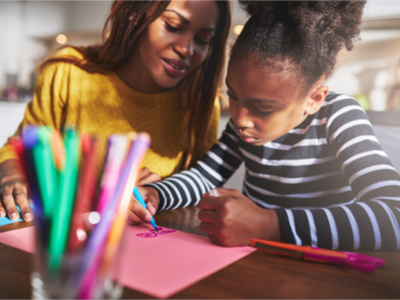Article by Judy Bartkowiak

I’m getting lots of calls and emails from parents who are experiencing behaviour in their child that is concerning them.
Many parents are also behaving in a way that isn’t normal for them and they feel guilty and ashamed of themselves, upset and remorseful. Children pick this up and it adds to their own anxiety when their parents also don’t seem to be coping very well.
Many parents aren’t getting much time alone together to share their worries or just to comfort and support each other as children are staying up later, struggle to get to sleep, have nightmares and want to sleep with their parents.
We all need new tools for coping with our mental health. We also need to go easy on ourselves. Now is not the time to set ourselves challenging goals nor expect our children to be able to concentrate on their schoolwork when they are wondering when they will see their friends again. Some children will, of course, find attention to schoolwork reassuring, it is what they want to do, but others will find it hard some days.
It is natural to be afraid, fear keeps us safe. It is fear that stops us getting too close to someone walking by us. It is fear that makes us sanitise when picking up some post or put away our food shopping, when we’ve returned from an activity outside our home.
In her book ‘Big Magic’ Elizabeth Gilbert talks about inviting ‘fear’ into the car on a road trip and asking them to sit on the back seat. By fear being on the journey (a metaphor for our life) it will stop us driving too fast, taking the bends too tight, going too near the edge of the road. Fear keeps us safe. It is a good thing to have.
However, Gilbert warns us that we should never let fear drive our car or fiddle with the controls. In fact when I was speaking at an event in London earlier this year, I suggested we imagine reaching back and pulling the screen across between us and our back seat passenger. They can be there and indeed we are grateful that they are but they may not control our driving.
When I explain this to children, they completely get it and understand that they should not be embarrassed or upset with themselves when they are fearful or anxious but instead be grateful and appreciative that they have this passenger to keep them safe. Having thanked fear for being there, they then need to acknowledge that they are ok, they can cope with the situation and have the skills they need to tell ‘fear’ that they can relax, all is well.
Another little explanation I give that they find helpful is to explain that our fear and anxiety is a bit like a smoke alarm going off when all we’ve done is burn the toast. The amygdala in the brain is designed to send out an alarm when danger is near but whilst that was essential in caveman times when there might be a sabre tooth tiger around the corner, being asked a difficult question by your teacher really isn’t a life or death situation and there is no need for the smoke alarm.
Children find these explanations helpful because teachers and parents frequently ask ‘why’ they feel this way. The ‘why’ question sends them to their conscious mind to find a logical answer that makes sense. But they can’t find it. Why? Because of course it isn’t about logical answers, their anxiety stems from core beliefs imprinted at birth or during the early years before their prefrontal cortex was even developed sufficient to process what happened.
Understanding what happens, understanding that it is just their brain’s smoke alarm being a bit over enthusiastic and knowing that it is a good thing that they are aware of their emotions, really comforts them so that when it happens next they can just stop and say, ‘there’s that smoke alarm, no need to panic, it’s just burnt toast’.
So now we understand and can help children understand, what can we do to help them?
- Remind them that they are brave and resourceful. Focusing on when they are anxious and looking at them in that concerned and loving way we do as parents, simply draws attention to a state of mind that they don’t want. We are people of influence so what we do shows them where they also need to out their attention. Instead, mark out times when they are brave, smart, resourceful, creative anything positive.
- Make a mindfulness jar. Take an empty jam jar and fill it with water. Invite them to choose different colour glitter for each of their thoughts – worrying thoughts, sad thoughts, happy thoughts, cross thoughts and so on. They can add the colour glitter representing each emotion into the water. Close the top and shake. Sit and watch as the glitter whirls around like their busy worried mind and then watch quietly as it settles just like their thoughts will do when they breathe deeply and slowly, noticing the worrying thoughts but letting them settle.
- Self-compassion break. Invite them to put their hands on their chest and tune in to how they feel (this is a great one for you too!)
“I feel……………..”
Then stretch out both hands in front of you and say:
“Children/Mums/Dads/Teachers all over the world are feeling this right now.”
Then take your hands back to your chest and say:
“And what I need now is……………”
This is a great way for children to realise that they are part of a universe of children all over the world who are feeling just like them. They aren’t alone. It also encourages them to become aware of their needs. Maybe they need a hug, a glass of milk, to say sorry, to have some quiet time.
- Five finger breathing. Hold your left hand up and use your index finger on your right hand to trace up the side of your left hand and gently run the finger up and down each finger of your left hand finishing with your thumb. As you go up one side of the finger, breathe in and as you go down the other side, breathe out. Now go back round repeating the action until you arrive back at the base of your little finger.
- Keep a gratitude journal. Encourage them to write in it every day before they go to bed. Ask them to make a short note of what they are grateful for from that day. Many children are struggling with sleep at the moment and it is worse at night, alone in the dark worrying about what tomorrow will bring. I like to ask them to write three things to encourage them to be curious to find things they’re grateful for and ideally something specific not simply ‘mum’ or ‘dad’ but something they specifically noticed and were grateful for. Again you might like to do this too. Remember they will pick up on how you are… no matter how much you think you’re hiding it!
About the author
 Judy Bartkowiak is an International NLP and EFT Trainer for parents, teachers and existing Practitioners/Coaches/Therapists. She shares her passion and skills in working with children and teens through training and has written myriad books on the subject. Judy owns and runs NLP & EFT Kids, which is a family coaching practice in Berkshire, England. Clients are typically children aged four to 18 years, their parents and sometimes the whole family.
Judy Bartkowiak is an International NLP and EFT Trainer for parents, teachers and existing Practitioners/Coaches/Therapists. She shares her passion and skills in working with children and teens through training and has written myriad books on the subject. Judy owns and runs NLP & EFT Kids, which is a family coaching practice in Berkshire, England. Clients are typically children aged four to 18 years, their parents and sometimes the whole family.Understanding Children & Teens: A Practical Guide for Parents, Teachers & Coaches By Judy Bartkowiak
WeAreTheCity covers the latest female centric news stories from around the world, focusing on women in business, careers and current affairs. You can find all the latest gender news here.
Don’t forget, you can also follow us via our social media channels for the latest up-to-date gender news. Click to follow us on Twitter, Facebook, Instagram, and YouTube.




